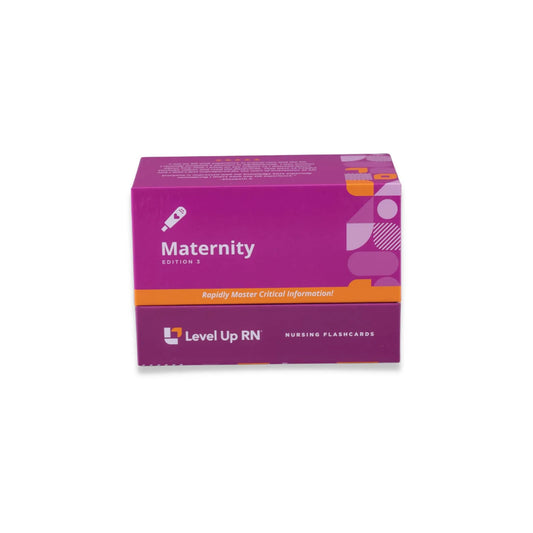In this article, we'll finish our coverage on contraception and explain what permanent sterilization is. Then we'll cover infertility, which is the inability to conceive for 6-12 months (depending on patient age). This is the last video and article in the preconception
This series follows along with our Maternity Nursing Flashcards which are intended to help RN and PN nursing students study for nursing school exams, including the ATI, HESI, and NCLEX.
Maternity Nursing - Flashcards
Contraception: Permanent Sterilization
Sterilization is any form of procedure that renders a patient unable to conceive—to become pregnant or to get others pregnant. The main procedures available for this are a vasectomy to remove sperm from semen and a tubal ligation to prevent eggs from being available to fertilize.
Tubal ligation
A tubal ligation is the ligation (tying) of the fallopian tubes in order to prevent sperm from reaching and then fertilizing an egg resulting in pregnancy.
Usually, the fallopian tubes are cut and cauterized which means they are medically burned with heat or caustic substance to be sealed off.
A tubal ligation is permanent and cannot be reversed. In order for a patient who has had a tubal ligation to have the possibility of becoming pregnant, they would likely need to undergo in vitro fertilization, where the egg and sperm are combined in a lab and then transferred directly to the uterus, skipping the fallopian tube step entirely. So, a tubal ligation does not prevent pregnancy from ever occurring again, but it prevents fertilization via sexual intercourse.
Essure procedure
An Essure procedure was a procedure in which coils were inserted into the fallopian tubes, allowing scar tissue to grow around them and essentially blocking the fallopian tubes, in order to prevent sperm from reaching and then fertilizing an egg resulting in pregnancy. This procedure is not covered in our Maternity Nursing Flashcards, and you are unlikely to be tested on it, because it has been discontinued in the United States since 2019. But you may encounter patients who had this procedure in the past.
Vasectomy
A vasectomy is the cutting and sealing of the vas deferens, which is the tube that carries sperm from the testicles, in order to remove the sperm from semen and prevent sperm reaching and fertilizing an egg resulting in pregnancy. The sperm are still produced, but they are not present in the semen.
After the vasectomy is done, a follow-up sperm count should be done to ensure there are no sperm in the semen, otherwise, it could lead to pregnancy.
Some vasectomies may be reversible, but this is considered a permanent procedure.
Infertility
In this section, we'll talk about infertility. If this is a sensitive subject for you, we invite you to skip this section. As Meris shares in the video, she herself went through infertility and received treatments for it, and it can be disruptive and distressing to a patient's life.
Infertility is defined as the inability to conceive for one year for patients under the age of 35, and for patients over the age of 35, it's the inability to conceive for 6 months. Inherent in the "inability to conceive" is that the patient is trying to conceive. The timeline is shorter for patients over the age of 35 because the risks and difficulty factors of a pregnancy increase with patients over the age of 35, so the timeline is considered shorter.
Infertility risk factors
Some infertility risk factors include: age (egg counts decrease with age), endometriosis because of the presence of scar tissue/inflammation, ovulation disorders like PCOS, tubal occlusions, hormonal disorders (which can include PCOS), low sperm count, or a history of mumps (which can cause inflammation of the testicles).
Infertility diagnostics
There are several diagnostic tests available for diagnosing the causes of infertility, including a semen analysis, hysterosalpingogram, or a hysteroscopy
Semen analysis
Semen analysis is often the first test performed to diagnose infertility, because it's very easy, not invasive, and much more affordable. This allows the provider to rule out (or "rule in") low sperm count. If low sperm count is identified as the cause, then it can be addressed. But if not, then further steps can be taken.
Hysterosalpingogram
Hysterosalpingogram is a long word that's easy to understand if you break it down!
- Hyster- means uterus (fun fact: this is where the word hysteria comes from; ancient doctors thought hysteria was a "woman's disorder" caused by the uterus moving around the body!),
- salping- means fallopian tube (like a salpingectomy which is removal of all or part of the fallopian tube in some cases of ovarian cancer)
- -ogram is a picture or drawing.
So, if you put uterus, fallopian tube, and picture together, you'll know that hysterosalpingogram is imaging of the uterus and fallopian tubes. Sometimes it's called HSG for short.
Usually, a hysterosalpingogram is done while the patient is awake or on twilight sedation. A camera is placed into the uterus and a contrast dye is infused into the uterus, and using fluoroscopy (video x-rays), the provider can see if the dye is able to travel through the fallopian tubes or if they are blocked.
Before a hysterosalpingogram, patients should be assessed for allergies to shellfish and iodine, since the contrast dye contains iodine and similar proteins that may trigger an allergic reaction.
Hysteroscopy
A hysteroscopy is a visual exam of the uterus, using a camera on a scope to assess the uterus for scar tissue or other abnormalities. A hysteroscopy is used as a diagnostic for infertility because abnormalities in the uterus could prevent implantation of a fertilized egg, resulting in infertility. This procedure often happens at the same time as a hysterosalpingogram.
Infertility treatment options
There are a variety of treatment options for infertility, including intrauterine insemination, in vitro fertilization, embryo transfer, donor eggs/embryo/sperm, or a gestational carrier (surrogate). These procedures come at great cost and time to patients and can be extremely stressful, so some patients may choose to say that these procedures are not for them, and go on to adopt.
Intrauterine insemination
Intrauterine insemination (IUI), sometimes referred to as artificial insemination, is when pre-collected and concentrated sperm is inserted directly into the uterus. Patients who use donor sperm may choose intrauterine insemination.
In vitro fertilization
In vitro fertilization, as we mentioned earlier, is a series of complicated procedures that includes when a sperm and an egg are combined in a lab and the resulting embryo or embryos are transferred to the uterus.
Embryo transfer/adoption
Embryo transfer or adoption is when a patient has an embryo transferred to their uterus that was not made from their own egg, but from someone else's egg. A patient may opt to use an embryo from someone that they know, or one that was donated.
How can an embryo be donated? When patients go through in vitro fertilization, there are sometimes extra embryos left over at the lab after the patient has successfully been able to get pregnant. These patients may choose to donate their embryos to another patient.
Donor eggs or sperm
Patients may opt to use donor sperm or donor eggs for a variety of reasons: if there is a problem with their own sperm or eggs, if they are in a same-sex couple, or if they are single and want to have a baby.
Gestational carrier (surrogacy)
Parents or a parent may work with a third person to be their gestational carrier or surrogate. Surrogacy can be "traditional" or gestational, depending on the origin of the egg. In "traditional" surrogacy, the surrogate's own egg is used—it's called traditional because it's older, and it was the only kind of surrogacy done before the technology evolved for gestational surrogacy.
In a gestational surrogacy, the egg of the parent is fertilized in vitro and transferred to the surrogate, so the surrogate is genetically unrelated to the baby.
Gestational surrogacy is a combination of in vitro fertilization and embryo transfer!


